The skeleton arose out of the mist as we walked along the beach. It was not frightening, but rather melancholy – the remains of a ship that had come to a sorry end on the Oregon coast.
We had come to the beach at Clatsop Spit, within Fort Stevens state park on the northwest tip of Oregon. While it was sunny and clear inland, when we arrived at the beach a strong fog was rolling in off the ocean, obscuring the view and adding to the misty mood.
Approaching the wreck we began to see more detail. Much of the bow’s superstructure remained, with the beams of its iron frame providing the skeleton’s ribs. Most of the rest of the ship had faired less well. It was the Peter Iredale.
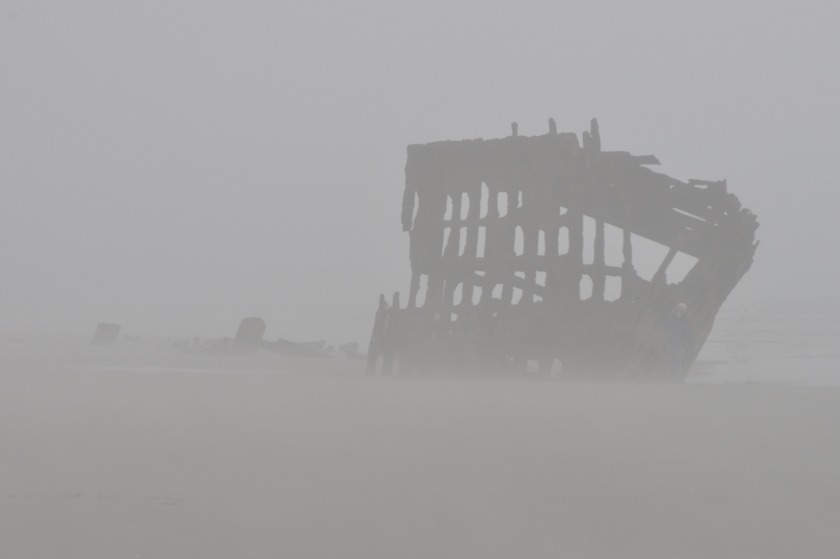
The Peter Iredale was a barque style sailing ship, originally built in 1890. Although the hull was of iron and steel it was still powered by sail, which helped contribute to its demise in 1906.
Late on the night of September 26 the Peter Iredale was heading north along the Pacific coast, en route to Portland, Oregon. After sighting the lighthouse at Tillamook Rock it altered its course northeast, heading for the Columbia River which it could follow into Portland. They’d sighted the distant lights from a lightship at the mouth of the river, but encountered a thick mist and lost sight of it. It was nasty that night, along with the poor visibility there was a squall out of the northwest. By the time they saw land it was too late to overcome the howling westerly winds pushing them ashore, and they grounded on the sands of Clatsop Spit.


The Peter Iredale, after grounding and in better days.
Images from iredale.de
The 27 crewmen were rescued without loss of life. Although the sands were kind to the hull and there were thoughts of refloating it, the tides did not cooperate and it was sold for scrap.
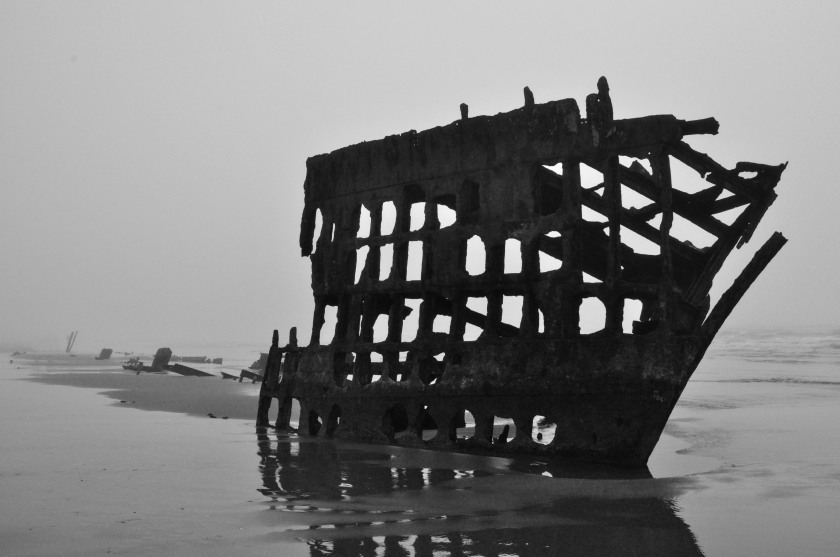
These days, 110 years later, what remains is a draw for tourists and campers at the state park. Every year, a bit less of the wreck survives the stormy season, and the ghost moves a bit closer to its final home.

Moving away from the wreck, other relics could be found. These too showed signs of age, but in a different way.
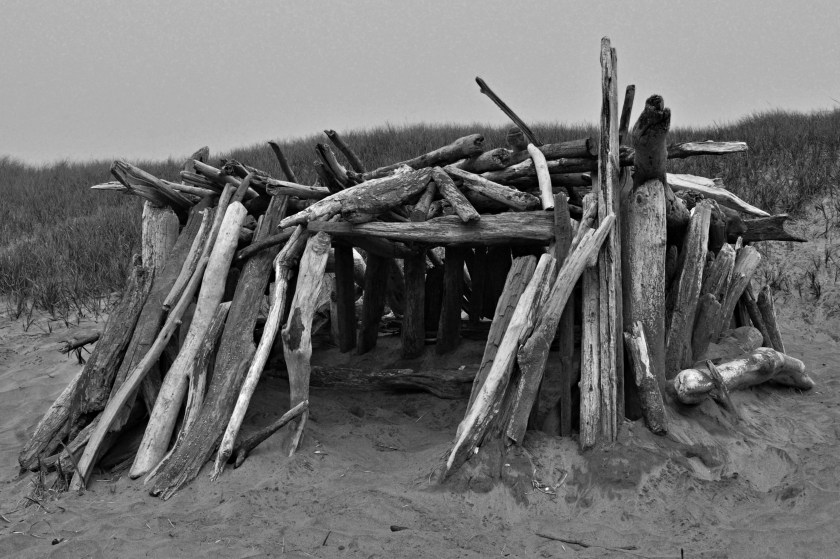
Some enterprising souls rescued a collection of driftwood from those who would mistake its rustic ambiance for firewood and built a little hut. Who knows how long it has been there: the timbers don’t tell, and they have longer stories anyway.
Other bits of flotsam have their own character.
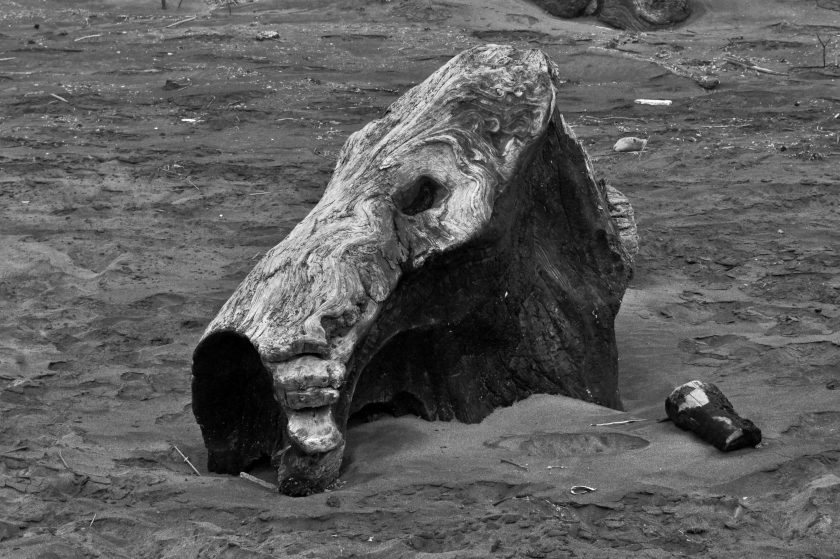
The last resting place for what looks like a moose’s head stands guard on the beach, keeping sentry against those who would leave their litter.
The remains of gnarled old stumps lay on the beach, looking like fallen soldiers from an ancient battleground. The Ents versus the Sea. Whorls, knobs, and textures that would make a lizard jealous adorn their skin.
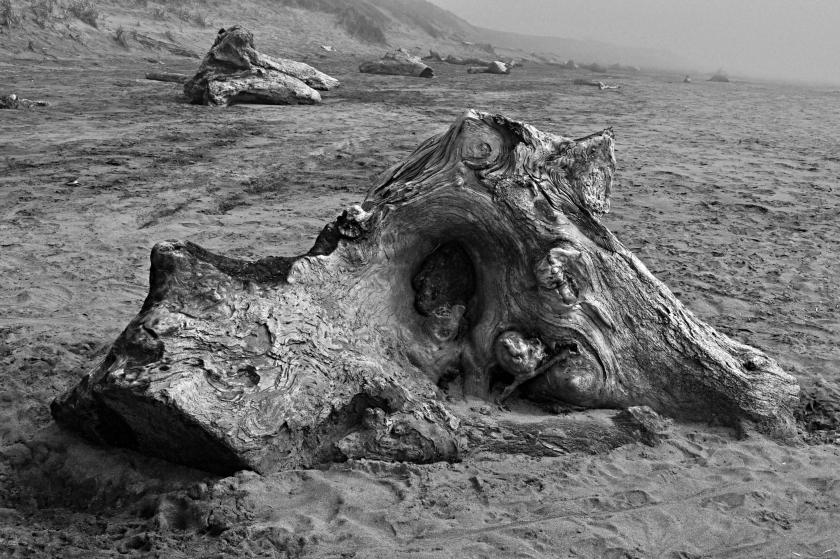
And so we returned to the ocean. In the quiet mood and the mists, I took a breath of sea air. How do you describe a smell? How does a blind man describe a color? The fragrance was subtle, and changed when a small breeze came along. It was soft and warm and moist, with just a hint of salt and iodine. It fit the grey somehow, and made me wonder – is this the smell of ghosts?



Dave, this is a great post. I like how you draw us in for a closer look at the wrecked ship, with both words and pictures. Love that first photo!
LikeLiked by 2 people
Thanks Monica. Coming from you that means a lot.
LikeLiked by 1 person
Fantastic photos and stories. Makes me pine for the PNW, some of my favorite spots on earth. There’s nothing like that combination of mist, gray, driftwood…the best.
LikeLiked by 2 people
Thanks Bill. Sounds like it will not be long before you see it again.
LikeLike
Too true, can’t wait.
LikeLiked by 1 person
Very nice post this is, along with great pictures.
LikeLiked by 2 people
Thanks Hammad.
LikeLiked by 1 person
So wonderfully moody, and a bit eerie as well. I love the gray tones, especially in that ethereal last shot.
LikeLiked by 1 person
Thanks Lex. That is exactly what I was going for. 🙂
LikeLiked by 1 person
A sad end for such a graceful ship.
LikeLiked by 2 people
I almost wish they still made tall ships, they look so elegant.
LikeLiked by 1 person
You drew us into the moment. Great photos too.
LikeLiked by 2 people
It was one of those, this is a lovely, moody place; how can I share it moments. Glad you enjoyed it.
LikeLike
Nice images, Dave. I’ll have to check out the Iredale the next time I’m down on the Oregon coast. It has been a few years since I walked on the beach right around there.
LikeLiked by 2 people
It had been many years since I’d been there, and it was a first for my wife. I’d never seen it in fog either.
LikeLike
Now, I thought you said that you couldn’t write, Dave? That is a superb post. And the photos complement it beautifully.
LikeLiked by 2 people
Thanks Mick. I’m not sure I’ve said I can’t write, but I do feel like a newbie in the creative writing area – I’d only written computer programs and technical documents before getting into blogging. I guess it helped to take a couple writing classes, and to have read a lot of books, newspapers, etc over the years.
LikeLiked by 1 person
Perhaps I mis-remembered your actual words – my apologies! But this sounds great.
LikeLiked by 1 person
Excellent post! I have not visited the Peter Iredale in years. I often wonder how much longer its skeletal remains will grace the beach.
LikeLiked by 2 people
Thanks Mark. When I was researching the wreck I saw a picture from about 15 years ago, and while the bow hasn’t changed that much there used to be more of the hull. I don’t know if its eroded or just gotten buried.
LikeLike
This post gave me goosebumps! I just might have to camp at Fort Stevens!
LikeLiked by 2 people
Yea, a successful ghost story! With only a hint of ghosts… 🙂
LikeLiked by 1 person
Atmospheric piece … a case of less is more!
LikeLiked by 2 people
It was kind of a minimalist scene, muted colors, not many people, the usual serenity of the surf, and the bones of the wreck.
LikeLike
Wonderful … does the US have the same upsurge of nature writing that we have in the UK – WG Sebald, Robert McFarlane, etc?
LikeLiked by 1 person
Thanks. 🙂 I don’t really know about the nature writers, when I have time for books my tastes tend to run to SciFi/Fantasy – can you consider Terry Pratchett a nature writer? I mean, he was a natural writer…
LikeLike
Pratchett was a fantasy writer who created convincing worlds, like many in the genre, so yeah guess so. 🙂
LikeLiked by 1 person
… also, like many of them, had an ecological perspective and moral message.
LikeLiked by 1 person
That was one of his strong points, the ability to sneak in social commentary while maintaining his whacky sense of humor. RIP Sir Terry.
LikeLiked by 1 person
What a wonderful atmosphere you managed to conjure up in your description of the place. I’d like to see the remains of the Peter Iredale sometime — preferably on a foggy day for maximum effect!
LikeLiked by 2 people
Well holler if you’re in the area – it’d be fun to show it to you. BTW, it also makes a nice backdrop for sunsets.
LikeLiked by 1 person
I can imagine. It’s probably also a great backdrop for telling ghost stories around a campfire.
LikeLiked by 1 person
You can imagine how much trouble I had holding that flashlight under my face while I was typing that story out. 😉
LikeLiked by 1 person
Great story/photo combo. I love it when words and pictures come together so deftly to tell a story.
LikeLiked by 2 people
Me too. Thanks Lindy.
LikeLike
Wonderfully evocative words and pictures Dave. I once lived fairly close to the ocean and hope to again some day. Walking on a deserted shore alone with your thoughts is one of life’s great pleasures.
LikeLiked by 2 people
Thanks Jason. I have to admit, the beach wasn’t entirely deserted, although there were a lot fewer folks than I’ve usually seen there. While on a few of the shots I could wait until nobody was in frame, I did cheat a little and digitally turned a couple people into ghosts.
Just the same, I agree. Walking along an ocean shore, even if there are a few people around, is one of life’s great restorative pleasures.
LikeLiked by 1 person
Really interesting and some stunning photos. Thanks for sharing. I came across a similar shipwreck on the coast of Ireland a few years ago. You might like to read about it https://melissashawsmith.com/2014/03/07/ready-for-her-close-up-the-wreck-of-the-sunbeam/
Happy travels! Melissa
LikeLiked by 2 people
Thanks Melissa. Nice piece on the Sunbeam, and you’re right, there are some interesting parallels.
PS: Thanks for the follow.
LikeLiked by 1 person